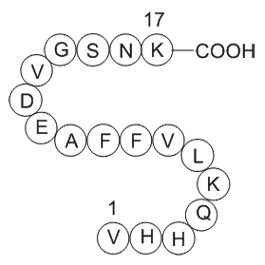Amyloid Beta-Peptide (12-28) (human) |
| Katalog-Nr.GP10049 |
Amyloid Beta-Peptide (12-28) (human) is a peptide fragment of amyloid beta protein (1-42) (Aβ (1-42)).
Products are for research use only. Not for human use. We do not sell to patients.

Cas No.: 107015-83-8
Sample solution is provided at 25 µL, 10mM.
Amyloid Beta-Peptide (12-28) (human) is a peptide fragment of amyloid beta protein (1-42) (Aβ (1-42)) [1]. One of the neuropathological features of Alzheimer's disease (AD) is the presence of amyloid deposits in senile plaques and in blood vessel walls [2]. Amyloid Beta-Peptide (12-28) was used as an internal standard [1].
Amyloid Beta-Peptide (12-28) (human) could efficiently suppress the formation of the α7nAChR.Aβ (1-42) complex. Using human brain tissues and cells that overexpress either the α7 nicotinic acetylcholine receptor (α7nAChR) or amyloid precursor protein as the starting material, Aβ (1-42) and α7nAChR can be co-immunoprecipitated by the respective specific antibodies, suggesting that they are tightly associated [3].
References:
[1]. Wang R, Sweeney D, Gandy SE, Sisodia, SS (1996) The profile of soluble amyloid b protein in cultured cell media. Detection and quantificaiton of amyloid β protein and variants by immunoprecipitation-mass spectrometry. J Biol Chem 271:31894-31902.
[2]. Terry R. D., and Davies P.(1983) Aging of the Brain (Samuel, D., Algeri, S.,Gershon ,S., Grimm, V., and Toffano, G., eds) Vol. 22, pp. 47-59, Raven Press
[3]. Wang, H. Y. et al. β-Amyloid1-42 binds to α7 nicotinic acetylcholine receptor with high affinity. Implications for Alzheimer's disease pathology. J. Biol. Chem. 275, 5626-5632 (2000).
Average Rating: 5 (Based on Reviews and 30 reference(s) in Google Scholar.)
GLPBIO products are for RESEARCH USE ONLY. Please make sure your review or question is research based.
Required fields are marked with *




















